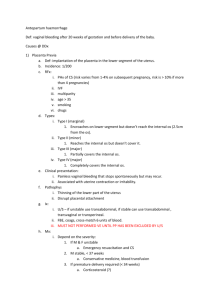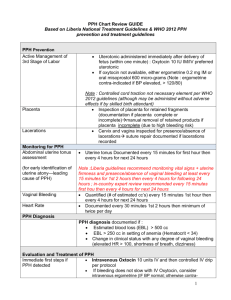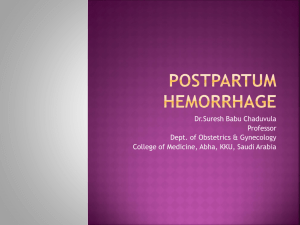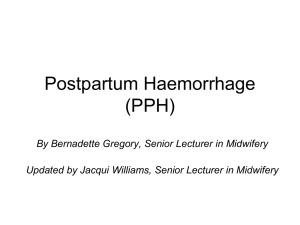Heavy bleeding after birth - the Royal College of Obstetricians and
advertisement
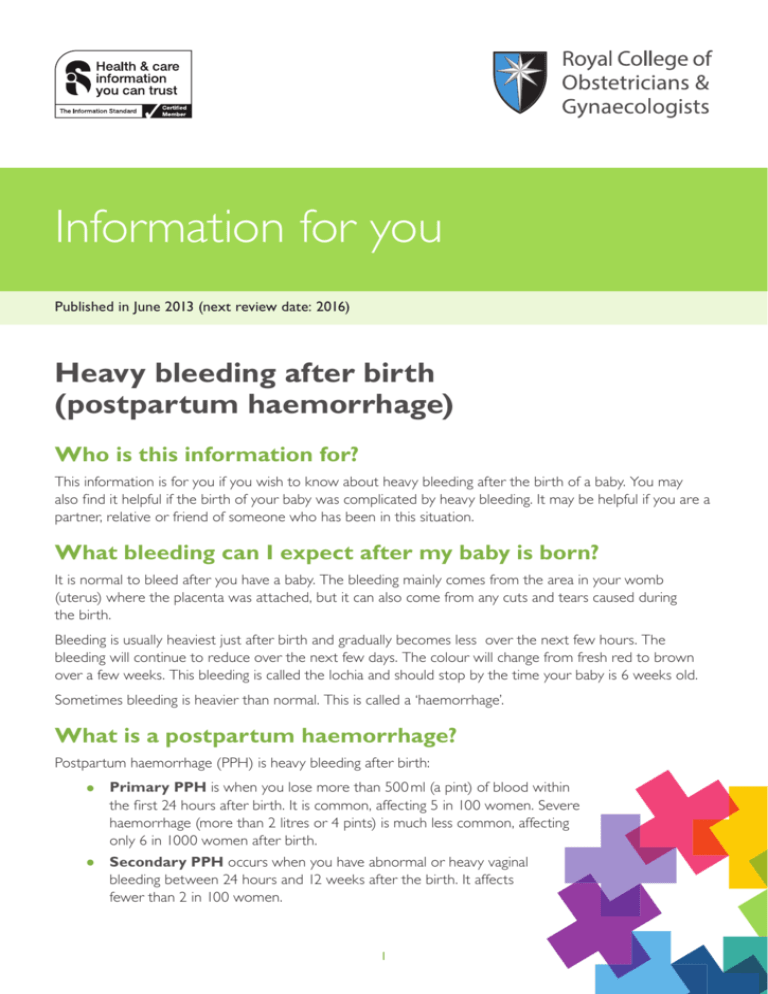
Information for you Published in June 2013 (next review date: 2016) Heavy bleeding after birth (postpartum haemorrhage) Who is this information for? This information is for you if you wish to know about heavy bleeding after the birth of a baby. You may also find it helpful if the birth of your baby was complicated by heavy bleeding. It may be helpful if you are a partner, relative or friend of someone who has been in this situation. What bleeding can I expect after my baby is born? It is normal to bleed after you have a baby. The bleeding mainly comes from the area in your womb (uterus) where the placenta was attached, but it can also come from any cuts and tears caused during the birth. Bleeding is usually heaviest just after birth and gradually becomes less over the next few hours. The bleeding will continue to reduce over the next few days. The colour will change from fresh red to brown over a few weeks. This bleeding is called the lochia and should stop by the time your baby is 6 weeks old. Sometimes bleeding is heavier than normal. This is called a ‘haemorrhage’. What is a postpartum haemorrhage? Postpartum haemorrhage (PPH) is heavy bleeding after birth: • Primary PPH is when you lose more than 500 ml (a pint) of blood within • the first 24 hours after birth. It is common, affecting 5 in 100 women. Severe haemorrhage (more than 2 litres or 4 pints) is much less common, affecting only 6 in 1000 women after birth. Secondary PPH occurs when you have abnormal or heavy vaginal bleeding between 24 hours and 12 weeks after the birth. It affects fewer than 2 in 100 women. 1 How could a PPH affect me? If you lose a lot of blood, it can worsen the normal tiredness that all women feel after having a baby. If heavy bleeding does occur, it is important that it is treated quickly. A major haemorrhage can be lifethreatening so it is important to prevent it if possible. Primary PPH Who is at risk? The table below shows the risk factors associated with primary PPH. Even if some apply to you, it is important to remember that most women with these risks factors will not experience a haemorrhage after giving birth. Before the birth In labour Risk factors for primary PPH Having had a PPH in a previous pregnancy Having a BMI (body mass index) of more than 35 Having had four or more babies before Carrying twins or triplets South Asian ethnicity Having a low-lying placenta (placenta praevia) The placenta coming away early (placental abruption) Pre-eclampsia and/or high blood pressure Anaemia Delivery by caesarean section Induction of labour Retained placenta Episiotomy (a surgical cut to help delivery) Forceps or ventouse delivery Labouring for more than 12 hours Having a big baby (more than 4 kg or about 9 lbs) Having your first baby if you are more than 40 years old • • • • • • • • • • • • • • • • • There is often very little that you can do about these factors but in some cases steps can be taken to reduce the risk of having a PPH and therefore the likelihood of needing a blood transfusion: • If you are anaemic during pregnancy, taking iron supplements may reduce the likelihood of needing • a blood transfusion if you have a PPH. Some women may also be offered iron supplements if they are at risk of anaemia. If you have had a caesarean section in a previous pregnancy, it is important to check that the placenta has not attached itself to the area of the previous scar. If it has, the placenta may not come away easily after birth. This condition (placenta accreta) is uncommon, but can cause major haemorrhage. If placenta accreta is suspected, you may be offered further scans and the team looking after you will discuss your options with you and make a plan for your care. Treating major haemorrhage may include having a blood transfusion (see below). If this worries you, talk to your midwife. If you have objections to receiving blood or other blood products, you will be referred to an obstetrician during your pregnancy to discuss your care plan. It is important that your wishes are known well in advance and written clearly in your notes. 2 What can be done during birth to reduce the chance of a primary PPH? If you have a vaginal birth, injecting the drug Syntocinon® (oxytocin) into your thigh just as the baby is born can help reduce blood loss. This injection helps the placenta to come away from the wall of your uterus normally. Once your placenta has been delivered, you will be examined for any tears. If these are bleeding heavily, they will be stitched promptly to reduce blood loss. If you have a caesarean section, Syntocinon will be injected into the drip in your vein and your placenta will be removed through the caesarean wound. What happens if I have a primary PPH? If you are in hospital, your midwife will push the emergency bell to call other members of staff into the room to help. It can happen quickly and people rushing into the room may be frightening for you and your birth partner. Your midwife will tell you and your partner what is happening and why. In the majority of cases, heavy bleeding will settle with the following simple measures. The midwife or doctor may: • massage your uterus through your abdomen to stimulate a contraction • give you a second injection (or a first, if you did not have one at the time of the birth) to help your • • • • uterus contract put a catheter (tube) into your bladder to empty it as this may help the uterus contract put a drip into your arm, and take some blood for testing check to make sure all the placenta has come out – if there are any missing pieces still inside your uterus, you may have to have them removed; this is usually done in an operating theatre under anaesthetic examine you to see whether any stitches are required if the bleeding continues after your uterus has contracted. Your blood pressure, temperature and pulse will be checked regularly and you will stay on the labour ward until the bleeding has settled. You can breastfeed if you wish. If you have had your baby at home or in a midwife-led unit, it is likely that you will be transferred to a consultant-led unit. What happens if I continue to bleed very heavily? If heavy bleeding continues and you have lost more than 1 litre (2 pints) of blood, a team of senior medical staff will be involved in your care. If you have lost a lot of blood, you are likely to feel dizzy, light-headed, faint or nauseous. You will be given oxygen and a second drip for extra intravenous fluids. Drugs will be used to help stop bleeding and you may be given a blood transfusion and fluids to help your blood clot. With fluids and blood, you should start to feel much better. You will be very closely monitored. If the bleeding continues, you may be taken to the operating theatre so the doctors can check for the cause of the haemorrhage. You will need an anaesthetic for this. Your partner will usually stay in your delivery room with your baby and will be kept informed about how you are and what is happening. There are several procedures your doctors might use to control the bleeding: • A ‘balloon’ may be inserted into your uterus to put pressure on the bleeding blood vessels. This is usually removed the following day. 3 • An abdominal operation (laparotomy) may be performed to stop the bleeding. • Very occasionally, a hysterectomy (removal of the womb) is necessary. This would only be • considered if other measures haven’t controlled the heavy bleeding. In some maternity units, uterine artery embolisation is performed to stop the bleeding. This procedure is done by a specially trained radiologist (X-ray doctor). A thin flexible tube is placed into an artery in your leg and guided, using X-ray images, to an artery in the uterus. Once there, a substance is injected to block the artery so that the bleeding from the uterus lessens. Once your bleeding is under control, you will either be transferred back to labour ward or you may be transferred to an intensive care or high dependency unit. You will be monitored closely until you are well enough to go to the postnatal ward. How will I feel afterwards? You may need a longer hospital stay. If tests show you are very anaemic or if you are feeling faint, dizzy or light-headed, you may be offered a blood transfusion. When you go home, you may still be tired and anaemic, requiring treatment with iron. You should recover over the following few weeks. You and your birthing partner may have found the experience distressing, and it is often helpful to talk through the events. You will have the opportunity to discuss what has happened before you leave the hospital. You may be offered, or can request, a further meeting with a senior member of the team who looked after you. If you continue to feel upset or you develop anxiety or depression after you go home, you should talk to your midwife, health visitor or GP. I have experienced a primary PPH in a previous pregnancy – what about future births? If you have had a previous birth that was complicated by a primary PPH, there is an increased risk of PPH in future pregnancies; overall, 1 in 10 women will have a PPH again in a future pregnancy. In view of this, you will be advised to have your baby in a consultant-led maternity unit. During pregnancy you may be advised to take iron supplements to reduce the chance of becoming anaemic. Having a caesarean section does not reduce your chance of a primary PPH. When you are admitted in labour, a blood sample may be taken to check your latest blood count and a cannula may be inserted into a vein in your arm so that fluids and medication can be given if necessary. You will be advised to have the drug Syntocinon to help the placenta come away and lessen the chance of a PPH. What happens if I have a secondary PPH? Secondary PPH is often associated with infection and usually occurs after you have left hospital. You should contact your midwife or GP if your bleeding is getting heavier or if your lochia has an offensive smell. You are likely to be given a course of antibiotics. If the bleeding is heavy or continues, you may be referred to hospital for blood tests and you may have an ultrasound scan. Depending on the results, you may be admitted to hospital. You may need antibiotics through a drip and/or less commonly an operation to clear your uterus of any infection, blood clots or small pieces of placenta that were not expelled after your baby was born. You may need to stay in hospital for a few days. Your baby can usually stay with you, if you wish, and you can continue to breastfeed even if you are taking antibiotics. 4 Key points • It is normal to bleed after you have a baby. Initially the bleeding can be quite heavy but it reduces • • • with time. You may continue to bleed after birth for several weeks. Sometimes bleeding is much heavier than expected and this is called postpartum haemorrhage (PPH). It is important to remember that the majority of women will not experience a haemorrhage after giving birth. If bleeding is very heavy, it is important to act quickly. Doctors and midwives are trained in controlling heavy bleeding. In the majority of cases, heavy bleeding will settle with simple measures. Further information For information on having a blood transfusion, see RCOG patient information on Blood Transfusion, Pregnancy and Birth, which is available online at: www.rcog.org.uk/blood-transfusion-pregnancy-and-birth. Sources and acknowledgements This information has been developed by the RCOG Patient Information Committee. It is based on the RCOG guideline Prevention and Management of Postpartum Haemorrhage (published by the RCOG in May 2009, revised in 2011). The guideline contains a full list of the sources of evidence we have used and is available at: www.rcog. org.uk/womens-health/clinical-guidance/prevention-and-management-postpartum-haemorrhage-green-top-52. The RCOG produces guidelines as an educational aid to good clinical practice. They present recognised methods and techniques of clinical practice, based on published evidence, for consideration by obstetricians and gynaecologists and other relevant health professionals. This means that RCOG guidelines are unlike protocols or guidelines issued by employers, as they are not intended to be prescriptive directions defining a single course of management. This information has been reviewed before publication by women attending clinics in London and Glasgow. A glossary of all medical terms is available on the RCOG website at: www.rcog.org.uk/womens-health/patientinformation/medical-terms-explained. A final note The Royal College of Obstetricians and Gynaecologists produces patient information for the public. The ultimate judgement regarding a particular clinical procedure or treatment plan must be made by the doctor or other attendant in the light of the clinical data presented and the diagnostic and treatment options available. Departure from the local prescriptive protocols or guidelines should be fully documented in the patient’s case notes at the time the relevant decision is taken. All RCOG guidelines are subject to review and both minor and major amendments on an ongoing basis. Please always visit www.rcog.org.uk for the most up-to-date version of this guideline. © Royal College of Obstetricians and Gynaecologists 2013 5


